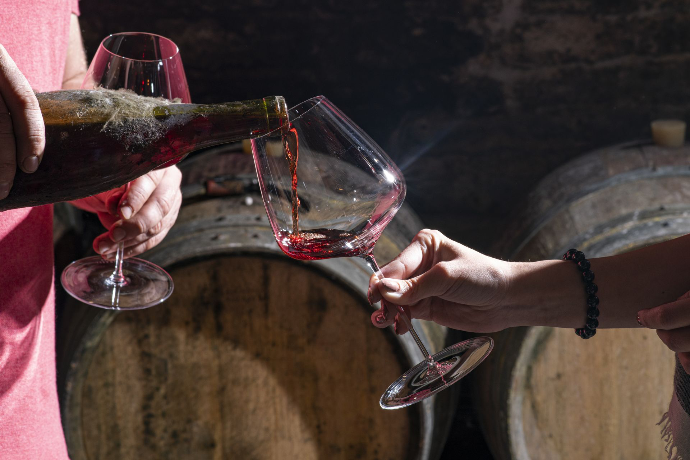Story #5 - Tipicity in Burgundy: Reflections from the Vineyards
September 10th, 2025 | Alexander Mackh, Co-Founder of Amelie
On paper, Burgundy as a wine region is small and unassuming, planted to very few grape varieties—Pinot Noir and Chardonnay, with an occasional appearance from Aligoté and Gamay. Despite this, the modest region has managed to enthral and beguile scholars and wine lovers more than any other, as it is without a shadow of a doubt the most complex place to study wine. There is no region in the world where the concepts of typicity, single vineyards, and the subtleties of soil, slope, and exposure have been given more thought. The beauty and strength of Burgundy lie here: one predominant red grape and one white deliver an eternal array of expressions.
At Amelie, what we value most is identity in wine, and nowhere are we better served on our quest to find such wines than in Burgundy. To understand originality here, one must look through three lenses: the producer, the village, and the drinker’s point of reference.

Producer: From Birth to Bottle
Many believe that a bottle hailing from a certain village or area of Burgundy carries only the signature of its stated origin, but over many years of visits to the world’s most mystical wine region, we have come to discover that other factors are at play in moulding the character of a given wine. The producer’s style and even location are as important as any factor when it comes to how a wine will present itself.
Let us use as an example a domaine situated in Chambolle-Musigny that crafts a wine from Nuits-Saint-Georges fruit. J.F. Mugnier is a producer that fits this exact case study: the celebrated Chambolle estate’s largest holding is Clos de la Maréchale, an almost ten-hectare 1er cru monopole in Nuits-Saint-Georges. The vineyard’s clay-limestone soils and exposure are quintessential Nuits, giving wines of depth, stern tannin, and darker fruit.
Once harvested, the wine’s story continues not in its vineyard but at the estate in Chambolle. There it comes to life through fermentation and undergoes its full barrel maturation before being bottled. The wine begins to absorb not only oxygen but also the influence of the cellar’s microbiome—ambient yeasts, bacteria, and even subtle humidity shifts that can shape aroma and texture. The stylistic choices made in Chambolle—harvest timing, whole-cluster use, oak regime—can soften Nuits’ natural structure and introduce Chambolle’s hallmark elegance. The place where a wine undergoes its élevage is often overlooked but undoubtedly a key factor in forming a given wine’s identity.
A producer’s style is not only a product of conscious choices but also of the location where a wine undergoes its maturation.
The Village: Expectations, Typicity, Tension
Burgundy’s villages each carry their own character with archetypal markers that allow the taster to ascertain whether a given wine gives a "true reflection" of its place. Nuits-Saint-Georges, for instance, is known for power, dark fruit, and firm tannin. Chambolle-Musigny is the benchmark of perfume and silky texture, its reds prized for finesse and floral lift. Vosne-Romanée sits between them, combining aromatic complexity with depth and spice.
Originality lives on a narrow path where the taster's expectations are met with exceptions. For instance, a wine may be unmistakably Nuits in character but display unexpected delicacy and finesse, or a Chambolle may be lifted and scented yet hint at darker undertones. These nuances—created by subtle shifts in soil composition, exposure, or slope—create tension between tradition and individuality: a space in which individuality lives and stereotypes die.
The Drinker: Reference and Recognition
Every Burgundy lover builds a personal reference library over time—memories of bottles and villages that define what each name means in the glass. Originality matters because it respects those reference points while offering something distinct. It is not novelty for its own sake but authenticity expressed with character.
A wine that perfectly mirrors its appellation can still feel generic if it lacks personality. One that bends expectations while staying rooted in its terroir becomes unforgettable.
A Closing Thought
Burgundy’s magic lies in its ability to be both clearly defined and surprising. Confuron-Gindre in Vosne-Romanée and Pierre-Olivier Garcia in Nuits-Saint-Georges are two of the rare estates that embody this principle. Their wines respect tradition and terroir yet speak with unmistakable personal voices. They reveal Burgundy not as a set of rigid rules but as a living landscape where character, place, and intent converge.
At Amelie, we believe these domaines hold some of the highest “originality scores” in the region—not because they aim to be different, but because they have the desire to allow each parcel and village to express itself truthfully and the skill to execute their vision. In a world where great Burgundy can sometimes feel uniform, these producers remind us why authenticity and identity still matter most. They are the reason we remain endlessly captivated by Burgundy’s complexity—and why we are proud to share their wines with you.